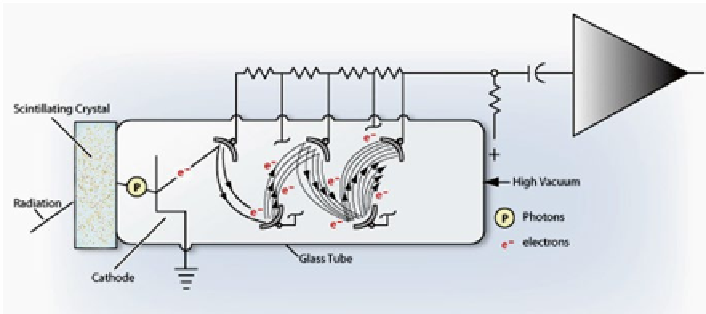Environmental Engineering Reference
In-Depth Information
Shale is a mixture of clay minerals, sand, silts, and other extraneous materials; thus,
there can be no “standard” gamma ray activity for shale. Indeed, the main clay min-
erals vary enormously in their natural radioactivity. Kaolinite has no Potassium,
whereas Illite contains between 4 and 8 % Potassium. Montmorillonite contains less
than 1 % Potassium. Occasionally, natural radioactivity may be due to the presence
of dissolved Potassium or other salts in the water contained in the pores of the shale.
Operating Principle of Gamma ray Tools
Gamma ray tools consist of a gamma ray detector and the associated electronics for
passing the gamma ray count rate to the surface. Traditionally, two types of gamma
ray detectors have been used in the logging industry: Geiger-Müeller and scintilla-
tion detectors. Today, practically all gamma ray tools use scintillation detectors con-
taining a sodium iodide crystal
1
(Fig.
11.5
). When a gamma ray strikes the crystal,
a single photon of light is emitted. This tiny flash of light then strikes a photo
cathode made from cesium antimony or silver magnesium. Each photon, when hit-
ting the photo cathode, releases a bundle of electrons. These in turn are accelerated
in an electric field to strike another electrode producing an even bigger bundle
(a shower) of electrons. This process is repeated through a number of stages until a
final electrode conducts a small current through a measure resistor to give a voltage
pulse that signals that a gamma ray struck the sodium iodide crystal. The system has
a very short dead time and can register many counts per second without becoming
swamped by numerous simultaneous signals.
Fig. 11.5
Scintillation counter. Courtesy Halliburton
1
Sodium Iodide (NaI) and Cesium Iodide (CsI) crystal detectors have relatively poor resolution.
Modern “High Resolution” GR logging tools now use Barium Germanite (BGO) detectors, which
have better resolution. The better resolution yet can be obtained, using intrinsic Germanium (GSO)
or Germanium-Iodide (GeI) or Lanthium Halide (LaBr3 - BrilLanCe™) which must be cryoge-
netically cooled.


Search WWH ::

Custom Search